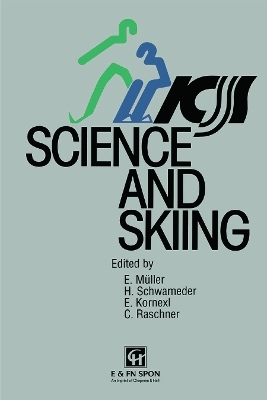
Science and Skiing
Spon Press (Verlag)
978-0-419-20850-1 (ISBN)
The main aim of the conference was to bring together original key research in this area and provid an essential update for those in the field. The lnk between theory and practice was also addressed, making the research more applicable for both researchers and coaches.
This book is divided into five parts, each containing a group of papers that are related by theme or disciplineary approach. They are as follows: Biomechanics of Skiing; Fitness testing and Training in Skiing; Movement Control and Psychology in Skiing; Physiology of Skiing and Sociology of Skiing.
The conclusions drawn from the conference represent an invaluable practical reference for sports scientists, coached, skiers and all those involved in this area.
E. Kornexl, E. Muller, C. Raschner, H. Schwameder
One: Biomechanics of Skiing; 1: Ski-Jumping Take-Off Performance: Determining Factors and Methodological Advances; 2: Load on the Locomotor System During Skiing. A Biomechanical Perspective; 3: Biomechanics of Ski-Jumping-Scientific Jumping Hill Design; 4: Joint Power Production in Take-Off Action During Ski-Jumping; 5: Inter- and Intra-Individual Variability of the Ski-Jumper's Take-Off; 6: Inverse Dynamic Analysis Of Take-Off in Ski-Jumping; 7: Effects of 50 KM Racing on Ski Skating Kinematics in the Falun World Championships in 1993; 8: Management of the Sport Training Process with Cross-Country Ski Runners Through Modern Apparatus Methods and Means; 9: A Mathematical Method for the Analysis of Trajectories in Giant Slalom; 10: Simulation Techniques Applied to Skiing Mechanics; 11: Turning the Skis Without 'Mechanisms of Turning'; 12: Muscle Activity of the Inside and Outside Leg in Slalom and Giant-Slalom Skiing; 13: The Effect of Different Uses of the Upper Limb on Body Coordination During Rhythmic Parallel Turning; 14: Pressure Distribution Measurements for the Alpine Skier-from the Biomechanical High Tech Measurement to its Application as Swingbeep-Feedback System; 15: Skiing Technique in Swing Turns: Distribution of Stress on the Hip-Joint Articular Surface; 16: Sensor Plates Designed for Measuring Forces Between Ski and Binding-a Developmental Summary; 17: Different Possibilities of Measuring Force Transmission Between Ski and Binding; 18: Ground-Reaction Forces in Alpine Skiing, Crosscountry Skiing and Ski Jumping; 19: Constraint Forces May Influence the Measurement of Vertical Ground Reaction Forces During Slalom Skiing; 20: Structural Dynamic Analysis of Alpine Skis During Turns; Two: Fitness Testing and Training in Skiing; 21: Evaluation and Planning of Conditioning Training for Alpine Skiers *; 22: Kinematic and Kinetic Analysis of Slalom Turns as a Basis for the Development of Specific Training Methods to Improve Strength and Endurance; 23: Types of Muscle Action of Leg and Hip Extensor Muscles in Slalom; 24: Predicting Skiing Performance in 14-18 Year Old Competitive Alpine Skiers; 25: Validity of Sport-Specific Field Tests for Elite and Developing Alpine Ski Racers; 26: Relationship of Anaerobic Performance Tests to Competitive Alpine Skiing Events; 27: Aspects of Technique-Specific Strength Training in Ski-Jumping; 28: Programme for the Objectivization of Sport-Specific Performance Preconditions, in the Long-Term Development of Performance of Crosscountry Skiers; Three: Movement Control and Psychology in Skiing; 29: Movement Regulation in Alpine Skiing; 30: The Technique of Gliding in Alpine Ski Racing-Safety and Performance; 31: A Profile of Sensorimotor Balance of Alpine Skiers; 32: Psychological Training in Alpine Skiing-Racing; 33: Incentive Motivation, Competitive Orientation and Gender in Collegiate Alpine Skiers; 34: Feelings of Movement in Alpine Skiing; 35: Optimal Emotions in Elite Cross-Country Skiers; 36: Structuring Cross-Country Skiing Techniques on the Basis of Motor-Program Theory; Four: Physiology of Skiing; 37: The Physiology of Competitive C.C. Skiing Across a Four Decade Perspective; with a Note on Training Induced Adaptations and Role of Training at Medium Altitude 1); 38: Physiological Indices of Elite Junior-I Alpine Skiers; 39: An Incremental Exercise Test Simulating the Muscular Activity of Slalom; 40: The Metabolic Load in Alpine Skiing-An Attempt at a Presentation Using Computer-Supported Modelling; 41: Fitness, Cardiovascular Stress, and Scd-Risk in Downhill Skiing; 42: Elite Skiers after Anterior Cruciate Ligament Reconstruction: Early Functional Sport-Specific Rehabilitation in Water; 43: Troponin I-A New Marker of Muscle Damage in Alpine Skiing; 44: Physiological Characteristics of Top Young Czech Cross-Country Skiers of Both Sexes; Five: Sociology of Skiing; 45: Pleasure First, Morale Last-On the Justification of Modern Winter Sports; 46: Skiing in Austria: Trends, Image and Identity; 47: Alpine Skiing in Social Change-A Pilot Study; 48: The Social Influences of Ski-Area Development in Japan; 49: Downhill and Telemark Skiing as Part of Young People's Lifestyle; 50: Alpine Winter Sport Resorts: Travel Motives and Dimensions of Service Quality
| Erscheint lt. Verlag | 21.11.1996 |
|---|---|
| Verlagsort | London |
| Sprache | englisch |
| Maße | 156 x 234 mm |
| Gewicht | 1350 g |
| Themenwelt | Sachbuch/Ratgeber ► Sport ► Ski- / Wintersport |
| Medizin / Pharmazie ► Medizinische Fachgebiete ► Sportmedizin | |
| Studium ► 1. Studienabschnitt (Vorklinik) ► Physiologie | |
| Weitere Fachgebiete ► Sportwissenschaft | |
| ISBN-10 | 0-419-20850-X / 041920850X |
| ISBN-13 | 978-0-419-20850-1 / 9780419208501 |
| Zustand | Neuware |
| Haben Sie eine Frage zum Produkt? |
aus dem Bereich


